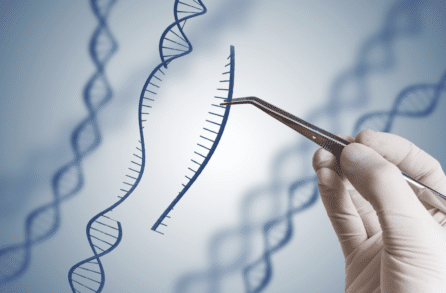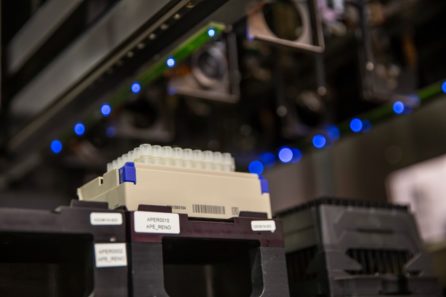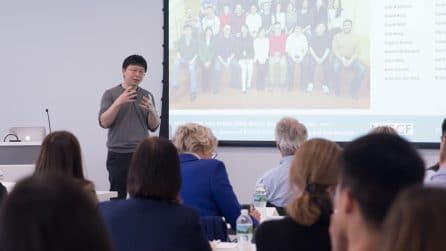The Gist of Gene Editing: Inside Biomedicine’s Hottest Tool
NewsGene editing: you’ve likely heard of it before, but what is the science behind biomedicine’s most versatile new star? How is it used for research and treatment? What ethical considerations must we address to keep gene editing safe? And where’s it going next? We sat down with NYSCF’s functional genomics team to get to the bottom of all these questions and more.
What is gene editing?
At its root, gene editing is exactly what it sounds like: it lets scientists locate and edit stretches of DNA within the genome.
“Our DNA consists of billions of small units that we call nucleotides (or bases), and it lives in the nucleus of each of our cells,” explained Josephine Wesely, PhD, NYSCF Principal Scientist in Functional Genomics. “It is the genetic code that determines how we look, how healthy we are, our eye color, and so much more.”

“If you think of the DNA in our cells as a recipe book, this book carries information on how to make, let’s say, a cake. And sometimes, the book has mistakes, or we don’t actually know every ingredient in a recipe. So what we try to do with gene editing is write the recipes correctly so the cake turns out as good as possible.”
How is gene editing used in disease research?
Editing genes can be useful for helping scientists understand how a genetic mutation associated with disease affects a cell, and in turn, how these effects can be prevented or treated.
“We can make a modification to DNA and see how this changes the cell,” said Dr. Wesely. “Is it still functional? Does it still do its job – for example: does a liver cell still metabolize as it should? So it’s a tool to investigate how our genetics influence how our bodies work.”
Especially in rare diseases, which are often the result of a single mutation, gene editing holds a lot of promise for research and treatment.
“For example, we work on a rare disease called Batten disease, where there is a mistake in DNA – essentially a long section that is missing – that leads to neurodegeneration,” explained Manali Nikte, NYSCF Scientist in Gene Editing. “So instead of invasive procedures on patients themselves, you might rather use a blood sample to make stem cells, turn them into brain cells, and study those. As gene editing scientists, we hope we can find a way to put that section of DNA back.”
“We like to work on rare diseases because big companies don’t focus on them as much, and we have a real opportunity to help,” added Dr. Wesely.
“And when it comes to more common diseases the approach is the same: we try to identify known genes involved in the disease and then modify the gene either to correct it, or sometimes to remove it completely in healthy cells to confirm if it is actually involved in the disease (i.e. if disrupting a gene causes Parkinson’s-like symptoms in neurons, that tells us the gene is likely playing a role in the disease).”
How is gene editing currently being used in treatments and where will it go next?
Gene therapy started a few years ago and has shown promising results in some diseases by introducing a correct copy of a mutated gene. However, this approach has its limitations because the mutated gene still exists in the cells, and we cannot always overcome the disease by that strategy. With novel and more precise techniques such as gene editing, we can now precisely target a mutated gene and correct the mutation. Promising clinical trials using this approach in blood disorders like sickle cell anemia have shown overwhelmingly positive results.
Next, the scientists hope to see this approach applied to other diseases like diabetes.
“I would definitely like to see diseases cured or better treated using gene editing,” remarked Iyawnna Hazzard, NYSCF Scientist in Functional Genomics. “For example, I work on a project that uses gene editing to create a ‘universal stem cell’ – essentially a cell that can bypass the immune system so it isn’t attacked when used in a therapy. This is especially relevant for diseases like type 1 diabetes, where the immune system targets pancreatic beta cells and prevents them from producing insulin. If we can create healthy beta cells from stem cells that evade the immune system, then we can potentially restore normal function.”
“As a type one diabetic myself, I’m hopeful that such a cell transplant will be available in the future,” said Dr. Wesely. “It’s really encouraging to see how the field is moving really fast in the right direction.”
But before any of this reaches the clinic, Dr. Wesely also stressed the importance of ensuring safety, especially in light of the adverse effects encountered by some early gene therapy patients.
“One big concern with gene editing, and rightly so, is safety,” she added. “We have to know that the change we’re making is doing what we want it to. Right now, the therapies for disorders like sickle cell anemia and other blood diseases work like this: we can take out blood stem cells from a patient, modify it in a lab, and make sure that everything is correct, and then retransplant the corrected cells.”
“As we start to think about approaching organs that aren’t easily accessible and whose cells perhaps can’t be edited outside the body, we have to make sure an ‘in vivo’ approach (editing the cells while inside the body) is safe. We understand more and more every day about gene editing, about the risks, and about the safety measurements, so I think we’ll get there.”
What do you enjoy about working on gene editing at NYSCF?
“What’s most special about NYSCF, I think, is how we approach biology and experiments,” noted Yu-Ren (Roy) Chen, NYSCF Scientist in Functional Genomics. “We have our automated system, The NYSCF Global Stem Cell Array®, which empowers us to do large scale experiments and answer biological questions in a way that we couldn’t if we were making all these cells manually. It’s a very unique environment in which to do science.”

“Working with the Array has been so interesting, because everywhere else I’ve worked, I’ve had to do so much manually that the Array can do with robots,” added Soha Patil, NYSCF Associate Scientist in Functional Genomics. “It’s so fascinating how this system can enable higher throughput work.”
“Another thing that I think is really special about NYSCF is the collaboration: I get to work with engineers, software developers, and other scientists with totally different backgrounds,” added Iyawnna. “If I have a question, there’s always someone I can turn to. I think in science, we’re used to seeing it on TV as someone in a lab doing experiments by themself, but really it’s such a collaborative process, and NYSCF encourages this really well.”
What are some of the ethical considerations around gene editing?
As gene editing becomes more advanced, an open dialogue about how and when to use it is essential.
“It’s not a black or white answer: there are many shades of gray,” said Dr. Wesely. “It depends on who you ask and where society is at the time, and that’s the case with all new technologies. The more we investigate a tool, the more we learn about how it can be used as well as its limitations. The more we know, the better we can adjust to make things as safe and effective as possible.”
“We also have to remember that everything that can be used for good can also be used for bad, and we have to have the correct regulatory practices in place to ensure that we maintain control. Keeping these discussions going will make sure we are proceeding in the best way possible.”
Why is now the time to be excited about gene editing?
“If you’re hearing about gene editing, you’re probably hearing about CRISPR [the revolutionary gene editing system pioneered in part by NYSCF – Robertson Stem Cell Investigator Feng Zhang, PhD approximately 10 years ago], but gene editing didn’t start with CRISPR,” explained Dr. Wesely. “Other techniques have been used to modify the genomes of cells for the last 50 years. And that’s good because the longer something has been around, the more time we’ve had to optimize and understand it.”

“What’s exciting is that now, thanks to CRISPR technology, pretty much every scientist can have access to gene editing and use it to investigate countless questions. And with so much work going on across fields, all this knowledge will help accelerate everyone’s work.”
“Even in the past five years, CRISPR has evolved so much,” added Manali. “So when Josi comes to us with a gene involved in a disease that we want to investigate, we have a big opportunity to design experiments and ask questions we couldn’t ask before. That’s the fun part: figuring out our approach and collaborating with other scientists and labs to understand what a gene does or how to correct for it. And it’s so exciting when we finally get a result: when I’m running around the lab, I try to remember what we’re working toward, and also the promise it holds for patients.”
What is your favorite part of your job?
Yu-Ren agrees with Manali – when something finally clicks into place, it makes everything worth it.
“My favorite part is when an experiment finally works as planned,” he said. “That moment is so joyful. Whether or not something will succeed in science isn’t guaranteed, and it can take a lot of troubleshooting, but when you find the solution, it’s exhilarating.”
“There’s so much that I really like doing here,” remarked Dr. Wesely. “With induced pluripotent stem cells we can look at many different diseases in many different people. When I started in this field, there were only a handful of stem cell lines that were used over and over in labs for many different diseases and investigations, this clearly does not reflect reality. Now we can make stem cells from different people of different ethnicities and disease experiences to find treatments that work for everyone. It’s so exciting to have this stem cell repository at NYSCF, and the capabilities to create many more.”
“As my team members mentioned, we work with automated systems in order to handle these many cell lines at a time, and to gene edit them in parallel. We don’t cure a disease by looking at one cell line – we only really understand the biology and the effects of different treatments by looking across many patients, and that’s something we’re able to do really well here.”

